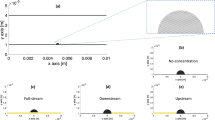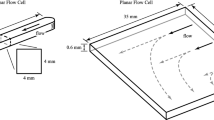Abstract
In contrast to their name, biofilms are not always flat and homogeneous but instead often exhibit complex structural heterogeneity. It has been suggested that nonhomogeneous geometry is selected in order to increase biofilm growth rate. A previous study (Dockery and Klapper (2002) SIAM J. Appl. Math., 62, 853–869) of a model biofilm system in a static bulk fluid demonstrated that under some circumstances a flat biofilm-bulk fluid interface is linearly unstable to perturbation due to growth induced forces. Computations indicated that subsequent nonlinear evolution results in fingers and mushrooms of biofilm similar to structures observed in actual biofilms. However, the important complementary issue of biological functionality was not considered. Here a weakly nonlinear analysis of the simple growing biofilm layer model in Dockery and Klapper (2002, SIAM J. Appl. Math., 62, 853–869) is presented. It is argued that, at least in the case of biofilms free of external mechanical stress, overall growth is in fact generally inhibited by the presence of growing perturbations in the linear stage. Hence a more complex explanation of function is necessary.
Similar content being viewed by others
References
Allison, D. G. (2003). The biofilm matrix. Biofouling 19, 139–150.
Balaban, N., Y. Gov, A. Bitler and J. R. Boelaert (2003). Prevention of Staphylococcus aureus biofilm on dialysis catheters and adherence to human cells. Kidney Int. 63, 340–345.
Beyenal, H. and Z. Lewandowski (2002). Internal and external mass transfer in biofilms grown at various flow velocities. Biotechnol. Prog. 18, 55–61.
Breyers, J. D. (Ed.) (2000). Biofilms II, New York: Wiley-LISS.
Byrne, H. M. (1999). A weakly nonlinear analysis of a model of avascular tumor growth. J. Math. Biol. 39, 59–89.
Chaplain, M., S. M. Giles and R. J. Jarvis (1995). A mathematical analysis of a model for tumour angiogenesis. J. Math. Biol. 33, 744–770.
Cogan, N. (2003). The role of the biofilm matrix in structural development. Math. Med. Biol. (submitted for publication).
Costerton, J. W. (1995). Overview of microbial biofilms. J. Ind. Microbiol. 15, 137–140.
Costerton, J. W., K.-J. Cheng, G. G. Geesey, T. I. Ladd, J. C. Nickel, M. Dasgupta and T. J. Marrie (1987). Bacterial biofilms in nature and disease. Annu. Rev. Microbiol. 41, 435–464.
Costerton, J. W., P. S. Stewart and E. P. Greenberg (1999). Bacterial biofilms: a common cause of persistent infections. Science 284, 1318–1322.
Dockery, J. D. and I. Klapper (2002). Finger formation in biofilms. SIAM J. Appl. Math 62, 853–869.
Eberle, H. J., D. F. Parker and M. C. M. van Loosdrecht (2001). A new deterministic spatiotemporal continuum model for biofilm development. J. Theor. Med. 3, 161–175.
Ermentrout, G. B. (1991). Stripes or spots? Nonlinear effects in bifurcation of reaction-diffusion equations on the square. Proc. R. Soc. Lond. A 434, 413–417.
Greenspan, H. P. (1974). On the self-inhibited growth of cell cultures. Growth 38, 81–95.
Greenspan, H. P. (1975). On the growth and stability of cell cultures and solid tumors. J. Theor. Biol. 56, 229–242.
Heersink, J., W. J. Costerton and P. Stoodley (2003). Influence of the Sonicare toothbrush on the structure and thickness of laboratory grown Streptococcus mutans biofilms assessed by digital time-lapse and confocal microscopy. Am. J. Dentistry 16, 79–83.
Heijnen, J. J., C. Picioreanu and M. C. M. van Loosdrecht (1998). Mathematical modeling of biofilm structure with a hybrid differential-discrete cellular automaton approach. Biotechnol. Bioeng. 58, 106–116.
Hermanowicz, S. W. (2001). A simple 2D biofilm model yields a variety of morphological features. Math. Biosci. 169, 1–14.
Klapper, I., C. J. Rupp, R. Cargo, B. Purvedorj and P. Stoodley (2002). A viscoelastic fluid description of bacterial biofilm material properties. Biotech. Bioeng. 80, 289–296.
Koerstgens, V., H.-C. Flemming, J. Wingender and W. Borchard (2001). Influence of calcium ions on the mechanical properties of a model biofilm of mucoid Pseudomonas aeruginosa. Wat. Sci. Technol. 43, 49–57.
Kreft, J. U. and J. W. Wimpenny (2001). Effect of EPS on biofilm structure and function as revealed by an individual-basedmodel of biofilm growth. Wat. Sci. Technol. 43, 135–135.
Møller, S., C. Sternberg, J. B. Andresen, B. B. Christensen, J. L. Ramos, M. Givskov and S. Molin (1998). In situ gene expression in mixed culture biofilms: evidence of metabolic interactions between community members. Appl. Env. Microbiol. 64, 721–732.
Ohashi, A. and H. Harada (1994). Adhesion strength of biofilm developed in an attached growth reactor. Wat. Sci. Tech. 29, 281–288.
Picioreanu, C. (2000). Multidimensional modeling of biofilm structure. PhD thesis, Delft University of Technology.
Schultz, M. P. and G. W. Swain (1999). The effect of biofilms on turbulent boundary layers. ASME J. Fluids Eng. 121, 44–51.
Stewart, P. S. (2003). Diffusion in biofilms. J. Bacteriol. 185, 1485–1491.
Stoodley, P., I. Dodds, J. D. Boyle and H. Lappin-Scott (1999a). Influence of hydrodynamics and nutrients on biofilm structure. J. Appl. Microbiol. 85, 19S–28S.
Stoodley, P., Z. Lewandowski, J. D. Boyle and H. Lappin-Scott (1999b). Structural deformation of bacterial biofilms by short term fluctuations in flow velocity: an in situ demonstration of biofilm viscoelasticity. Biotech. Bioeng. 65, 83–92.
Stoodley, P., K. Sauer, D. G. Davies and J. W. Costerton (2002). Biofilms as complex differentiated communities. Annu. Rev. Microbiol. 56, 187–209.
Stoodley, P., S. Wilson, L. Hall-Stoodley, J. D. Boyle and H. Lappin-Scott (2001). Growth and detachment of cell clusters from mature mixed species biofilms. Appl. Environ. Microbiol. 67, 5608–6513.
Towler, B. W., C. J. Rupp, A. Cunningham and P. Stoodley (2003). Viscoelastic properties of a mixed culture biofilm from rheometer creep analysis. Biofouling (in press).
Wanner, O. and P. Riechert (1996). Mathematical modeling of mixed-culture biofilm. Biotechnol. Bioeng. 49, 172–184.
Wentland, E. J., P. S. Stewart, C.-T. Huang and G. A. McFeters (1996). Spatial variations in growth rate within Klebsiella pneumoniae colonies and biofilms. Biotechnol. Prog. 12, 316–321.
Wimpenny, J. W. T. and R. Colasanti (1997). A unifying hypothesis for the structure of microbial biofilms based on cellular automaton models. FEMS Micro. Ecol. 22, 1–16.
Wood, B. D. and S. Whitaker (1999). Cellular growth in biofilms. Biotech. Bioeng. 64, 656–670.
Xu, K. D., P. S. Stewart, F. Xia, C.-T. Huang and G. A. McFeters (1998). Spatial physiological heterogeneity in Pseudomonas aeruginosa biofilm is determined by oxygen availability. Appl. Environ. Microbiol. 64, 4035–4039.
Zhang, X. and P. L. Bishop (2003). Biodegradability of biofilm extracellular polymeric substances. Chemosphere 50, 63–89.
Author information
Authors and Affiliations
Rights and permissions
About this article
Cite this article
Klapper, I. Effect of heterogeneous structure in mechanically unstressed biofilms on overall growth. Bull. Math. Biol. 66, 809–824 (2004). https://doi.org/10.1016/j.bulm.2003.11.008
Received:
Accepted:
Issue Date:
DOI: https://doi.org/10.1016/j.bulm.2003.11.008




